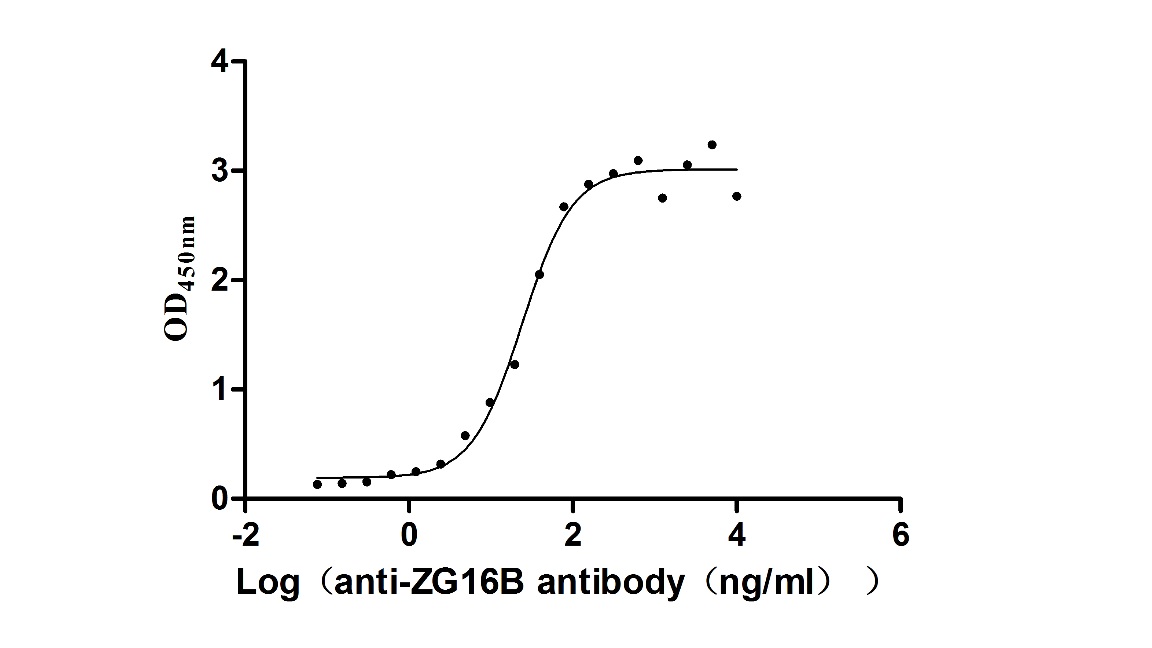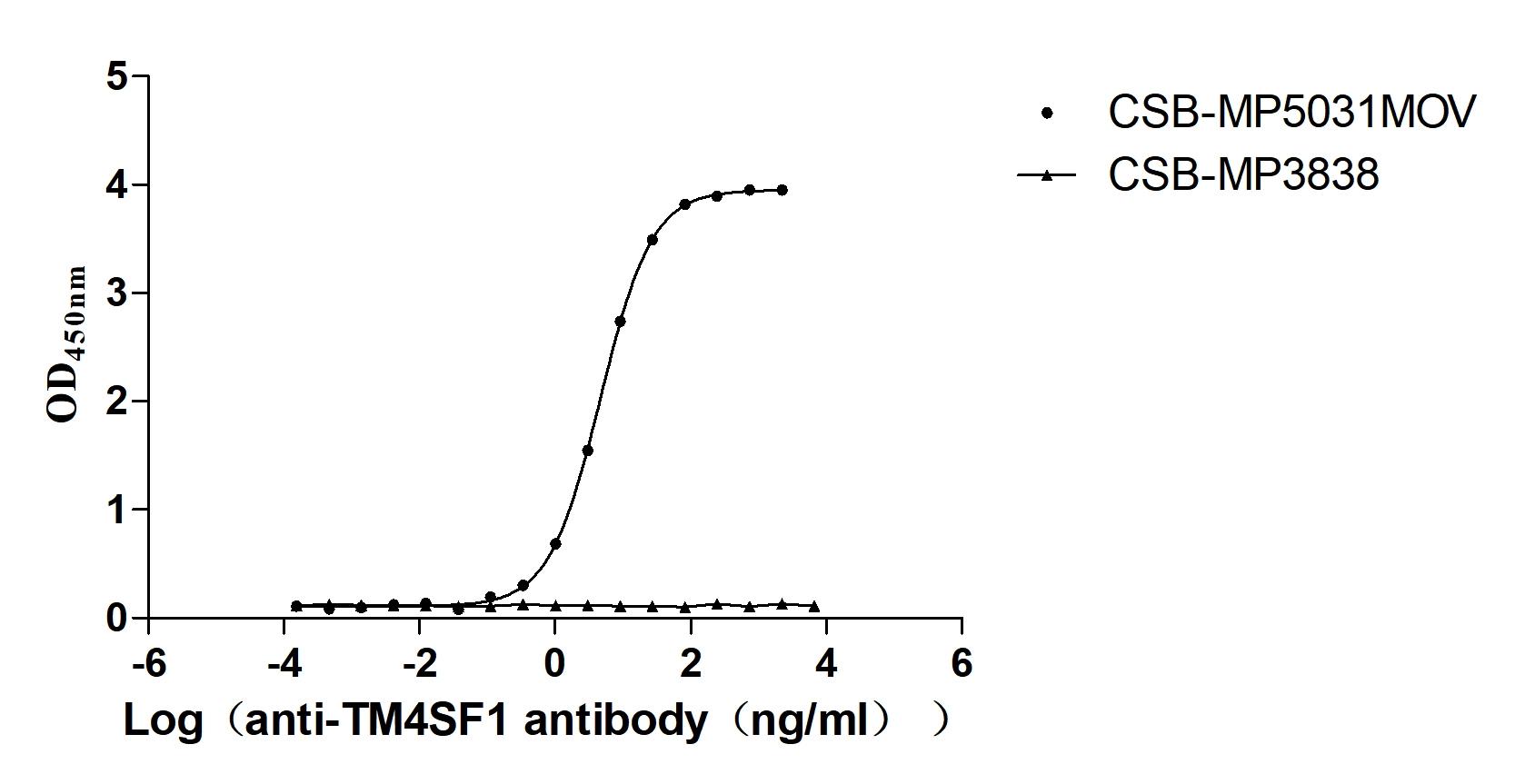Recombinant Human Natural cytotoxicity triggering receptor 2 (NCR2)
-
货号:CSB-CF015550HU
-
规格:
-
来源:in vitro E.coli expression system
-
其他:
产品详情
-
基因名:
-
Uniprot No.:
-
别名:NCR2; LY95; Natural cytotoxicity triggering receptor 2; Lymphocyte antigen 95 homolog; NK cell-activating receptor; Natural killer cell p44-related protein; NK-p44; NKp44; CD antigen CD336
-
种属:Homo sapiens (Human)
-
蛋白长度:Full Length of Mature Protein
-
表达区域:22-276
-
氨基酸序列QSKAQVLQSVAGQTLTVRCQYPPTGSLYEKKGWCKEASALVCIRLVTSSKPRTMAWTSRFTIWDDPDAGFFTVTMTDLREEDSGHYWCRIYRPSDNSVSKSVRFYLVVSPASASTQTSWTPRDLVSSQTQTQSCVPPTAGARQAPESPSTIPVPSQPQNSTLRPGPAAPIALVPVFCGLLVAKSLVLSALLVWWGDIWWKTMMELRSLDTQKATCHLQQVTDLPWTSVSSPVEREILYHTVARTKISDDDDEHTL
Note: The complete sequence including tag sequence, target protein sequence and linker sequence could be provided upon request. -
蛋白标签:N-terminal 10xHis-tagged
-
产品提供形式:Liquid or Lyophilized powder
Note: We will preferentially ship the format that we have in stock, however, if you have any special requirement for the format, please remark your requirement when placing the order, we will prepare according to your demand. -
缓冲液:Lyophilized from Tris/PBS-based buffer, 6% Trehalose, pH 8.0
-
储存条件:Store at -20°C/-80°C upon receipt, aliquoting is necessary for mutiple use. Avoid repeated freeze-thaw cycles.
-
保质期:The shelf life is related to many factors, storage state, buffer ingredients, storage temperature and the stability of the protein itself.
Generally, the shelf life of liquid form is 6 months at -20°C/-80°C. The shelf life of lyophilized form is 12 months at -20°C/-80°C. -
货期:Basically, we can dispatch the products out in 1-3 working days after receiving your orders. Delivery time may differ from different purchasing way or location, please kindly consult your local distributors for specific delivery time.Note: All of our proteins are default shipped with normal blue ice packs, if you request to ship with dry ice, please communicate with us in advance and extra fees will be charged.
-
注意事项:Repeated freezing and thawing is not recommended. Store working aliquots at 4°C for up to one week.
-
Datasheet & COA:Please contact us to get it.
相关产品
靶点详情
-
功能:Cytotoxicity-activating receptor that may contribute to the increased efficiency of activated natural killer (NK) cells to mediate tumor cell lysis.
-
基因功能参考文献:
- Study identified a novel ligand for NKp44 on astrocytes. Expression of this novel ligand decreased with increasing HIV-3S peptide concentration and blocking this novel ligand decreased NK cell killing. NK cell killing of astrocytes was decreased when astrocytes were incubated with HIV-3S peptide. NKp44 has a protective effect on astrocytes from NK cell mediated killing during HIV infection and impact astrocyte's role. PMID: 29447242
- NKp44 and NKp30 splice variants profiles are tissue/condition specific and demonstrate similarity between placenta and cancerous tissues. PMID: 27765926
- NKp44-1 expression was significantly associated with poor survival of AML patients. Moreover, activation of PBMC from healthy controls showed co-dominant expression of NKp44-1 and NKp44-3, while primary NK clones show more diverse NKp44 splice variant profiles. PMID: 27102296
- On CD56(+) CD3(-) cells, NKp44 and NKp46 expressions were high in the acute hepatitis E patients, whereas NKp30, NKp44, NKp46 and NKG2D were high in the recovered individuals. PMID: 24824867
- demonstrated that the mitogen and iK562 exposure to peripheral blood mononuclear cells can significantly improve NK activity which is co-related to the higher expression of NKp44 and NKG2D PMID: 24154937
- NCR(+) ILC3 from skin and blood of psoriasis patients produced IL-22, which is regarded as a key driver of epidermal thickening, suggesting that NCR(+) ILC3 may participate in psoriasis pathology. PMID: 24658504
- Balance between activating NKG2D, DNAM-1, NKp44 and NKp46 and inhibitory CD94/NKG2A receptors determine natural killer degranulation towards rheumatoid arthritis synovial fibroblasts. PMID: 24673109
- NKp44+ ILC3 are expressed in human skin and blood and may have a role in psoriasis pathogenesis PMID: 24352038
- Expression of NKp44 ligand by normal articular chondrocytes is not involved in their killing by unstimulated NK cells; however, it is responsible for anti-chondrocyte cytotoxicity mediated by long-term activated NK cells. PMID: 24044960
- MLL5 is a cellular ligand for the natural cytotoxicity receptor NKp44. PMID: 23958951
- Natural killer cells in HIV controller patients express an activated effector phenotype and do not up-regulate NKp44 on IL-2 stimulation. PMID: 23818644
- Novel interaction between proliferating cell nuclear antigen and HLA I on the surface of tumor cells inhibits NK cell function through NKp44. PMID: 23527218
- triggering in RORgammat-positive innate lymphoid cells selectively activates a proinflammatory program PMID: 23791642
- While interaction of TLR2 with mycobacterial cell wall promotes activation of resting NK cells and IFN-gamma production, NKp44 interaction with its putative ligands could play a secondary role in maintaining cell activation PMID: 23578092
- Natural cytotoxicity receptors play a major role in the recognition by NK cells of cancer stem cells targets. PMID: 23345327
- These data show that the Kaposi's sarcoma-associated herpesvirus ORF54 product downregulates the NKp44 ligand and that the NKp44-NKp44 ligand signaling pathway contributes to antiviral immunity. PMID: 22674989
- a precise analysis of clinical data showed a correlation between decreased NCR expression and poor prognosis factors such as low haemoglobin level, high (>30x10(9) per litre) lymphocyte count or elevated C-reactive protein PMID: 22044312
- We demonstrate that PCNA promotes cancer survival by immune evasion through inhibition of NKp44-mediated NK cell attack. PMID: 22021614
- Data show that pDCs isolated from peripheral blood of systemic lupus erithematosus (SLE) patients express lower levels of LAIR-1 while displaying slight but consistent expression of NKp44. PMID: 21151495
- The balance of NKp44(+)/NKp46(+) NK cells is disrupted in intestinal mucosa of patients with Crohn's disease. PMID: 20638936
- crystallization and preliminary crystallographic characterization of the extracellular Ig-like domain of human natural killer cell activating receptor PMID: 12351833
- The human TREM gene cluster at 6p21.1 encodes both activating and inhibitory single IgV domain receptors and includes NKp44. PMID: 12645956
- homology of the gene on chromosome 6, close to MHC class I loci to the most common bacterium in postdiarrheal Reiter's syndrome may be significan PMID: 12653925
- Selective cross-talk among natural cytotoxicity receptors (NKp46, NKp30 and NKp44) in human natural killer cells. PMID: 12731048
- The 2.2 A crystal structure of NKp44 presented here shows that the NKp44 Ig domain forms a saddle-shaped dimer, where a charged surface groove protrudes from the core structure in each subunit. PMID: 12791260
- All activating properties and surface expression of NKp44 are mediated through its association with DNAX-activation protein 12 (DAP12) in NK cells, and the cytoplasmic inhibitory domain of NKp44 does not appear to attenuate activating function. PMID: 14707061
- NKG2D, NKp30, NKp44, and NKp46 acitvation affected by ligand-negative phenotype in bone marrow-derived progenitor cells, acquisition of cell-surface ligands during myeloid differentiation, defective expression of ligands on malignant transformation PMID: 15657183
- NKp44 is not only a triggering molecule essential for antitumor activity but is also a surface receptor involved in natural killer cell suicide. PMID: 15728472
- NKp44 is present on a subset of natural interferon-producing cells (IPCs) in tonsils. Crosslinking of NKp44 does not trigger IPC-mediated cytotoxicity but, paradoxically, inhibits IFN-alpha production by IPCs in response to CpG oligonucleotides. PMID: 15941912
- Freshly isolated natural killer (NK) cells are NKp44 negative; lysis of porcine endothelial cells mediated by activated human NK cells depends on both NKp44 and NKG2D PMID: 16210654
- Characterization of the recognition of tumor cells by NKP44 is reported. PMID: 17536787
- Determined expressions of NKp44 in decidual natural killer cells in patients having spontaneous abortions. PMID: 18023431
- Recombinant NKp44 recognizes H5-expressing cells and specifically interacts with soluble H5 hemagglutinin. PMID: 18077718
- Expression of NKp30 and NKp44 ligands was variable and did not correlate with the origin of the cell line. Expression of NKp30 and NKp44 ligand correlated with NKp30 and NKp44-mediated NK cell lysis of tumor cells, respectively PMID: 18092004
- Natural killer (NK)-activating receptor NKp44 is involved in virally mediated NK activation through direct interaction with the flavivirus envelope protein. PMID: 19635919
显示更多
收起更多
-
亚细胞定位:Cell membrane; Single-pass type I membrane protein.
-
蛋白家族:Natural cytotoxicity receptor (NCR) family
-
组织特异性:Selectively expressed by activated NK cells and by in vitro cultured (i.e. activated) TCRg/d lymphoid cells.
-
数据库链接:
HGNC: 6732
OMIM: 604531
KEGG: hsa:9436
STRING: 9606.ENSP00000362181
UniGene: Hs.194721
Most popular with customers
-
Recombinant Human Glucagon receptor (GCGR), partial (Active)
Express system: Mammalian cell
Species: Homo sapiens (Human)
-
Recombinant Macaca fascicularis zymogen granule protein 16 homolog B (ZG16B) (Active)
Express system: Mammalian cell
Species: Macaca fascicularis (Crab-eating macaque) (Cynomolgus monkey)
-
Recombinant Mouse Cell adhesion molecule 1 (Cadm1), partial (Active)
Express system: Mammalian cell
Species: Mus musculus (Mouse)
-
Recombinant Human Cadherin-17 (CDH17), partial (Active)
Express system: Mammalian cell
Species: Homo sapiens (Human)
-
Recombinant Macaca fascicularis Transmembrane 4 L6 family member 1 (TM4SF1)-VLPs (Active)
Express system: Mammalian cell
Species: Macaca fascicularis (Crab-eating macaque) (Cynomolgus monkey)
-
Recombinant Human Kidney-associated antigen 1(KAAG1) (Active)
Express system: E.coli
Species: Homo sapiens (Human)
-
Recombinant Human Cadherin-1(CDH1),partial (Active)
Express system: Mammalian cell
Species: Homo sapiens (Human)
-
Recombinant Human C-C chemokine receptor type 9 (CCR9)-VLPs (Active)
Express system: Mammalian cell
Species: Homo sapiens (Human)




















